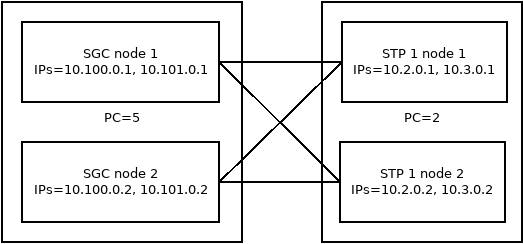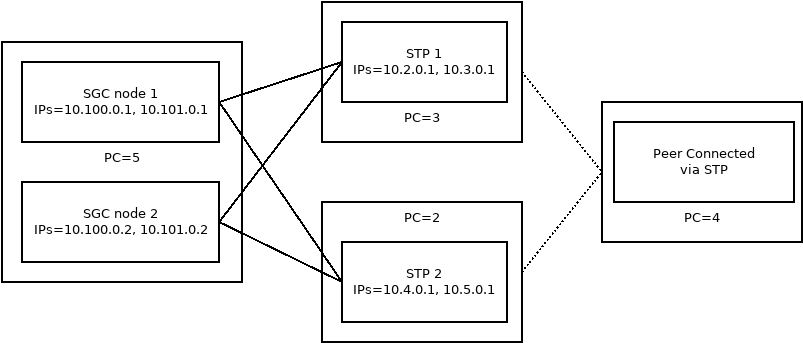The Rhino VoLTE TAS SGC requires the configuration of the networking details of its remote peers. These remote peers host application servers (AS) that interact with the Rhino VoLTE TAS’s SS7 signaling.
What you need
-
❏ The remote peer addresses that act as the signal transfer points (STP) in the network.
-
❏ The AS(s) accessible via these remote peer addresses.
-
❏ The AS destination point code(s) (DPC).
-
❏ The subsystem number(s) (SSN) to monitor for each of the DPCs.
Remote peer configuration
The remote M3UA peer application servers in the network are designated in the peers section.
Multiple remote peers to the Rhino VoLTE TAS’s SGC can be defined here.
What you need
For each remote M3UA AS peer, define the following:
-
❏ A unique
idfor each remote peer. -
❏ The set of IPv4 addresses that belong to the server peer. This is defined in
remote-ips. -
❏ Whether a specific SMO node or any SMO node in the Rhino VoLTE TAS should communicate with the peer’s set of IP addresses. This is defined in
node-index. -
❏ At least one AS ID defined in
as-idwhich is related to the remote peer. This is defined inapplication-servers.
Optional configuration may include:
-
❏ The
portfor the remote peer. -
❏ Whether the SGC takes an active role in M3UA state maintenance or not with the peer. This is set in the
state-maintenance-rolefield. -
❏ Whether the SGC connects to the remote peer (client mode) or waits for a connection from the remote peer (server mode). This is set in the
conn-typefield. -
❏ Whether the SGC is an IP server Process (IPSP) for the peer or not. This is set in the
is-ipspfield. -
❏ Whether to define the
asp-idto use in ASP-UP/DOWN messages. -
❏ For a specified AS
as-id, whether to send Destination State Audit (DAUD) when the Application Server Process (ASP) goes active in this AS. This is set in thedaud-on-asp-acfield.
Example configuration
In the following example snippet, two remote peers are configured.
They are both configured to:
-
the same port number of 2906
-
have no restriction on what SMO node in the Rhino VoLTE TAS they can communicate with
-
correspond to the same AS identifier that is defined in the
application-serversexample -
each have their own distinct sets of IP addresses.
deployment-config:sgc:
m3ua:
remote:
peers:
- id: 'STP-1'
remote-ips:
- node-index: -1
ips:
- 10.14.144.71
- 10.14.144.134
port: 2906
application-servers:
- as-id: 'NN-AS'
- id: 'STP-2'
remote-ips:
- node-index: -1
ips:
- 10.14.144.81
- 10.14.144.144
port: 2906
application-servers:
- as-id: 'NN-AS'Defined application servers
The SGC interacts with known application server(s) for routing SS7 signaling.
These ASs are accessible on the remote peer addresses configured in peers.
The declarative configuration defines these ASs in the application-servers list.
What you need
For each M3UA AS hosted on these remote peers, define the following:
-
❏ A unique
idfor each AS that the SGC interacts with. This value is only used by the declarative configuration and is not exposed externally. -
❏ A
default-priorityfor any routes for the AS. -
❏ The list of
dpc-idsthat may be accessible from the AS. This includes for each DPC:
Optional configuration may include:
-
❏ Whether the AS would assume an active or passive
traffic-maintenance-role. -
❏ Whether the AS has a
routing-context. -
❏ Whether to not allow the AS to be become active until there is at least one connected TCAP for each specified SSN. This is accessed in the
precond-ssnsfield.
Defined DPCs
The SGC interacts with known DPCs for routing SS7 signaling through application servers.
Multiple DPCs can be defined in the dpcs section.
What you need
For each designated DPC in the network interacting with the SGC, we must define:
Optional configuration may include the DPC’s:
Example configuration
In the following example snippet, the SGC is configured to communicate with a remote DPC used by the AS.
SGC has the remote DPC configured to have:
-
an configuration specific identifier of the configured DPC 'alias-2-233-3' to connect to the AS configuration
-
an actual DPC code of
5963 -
a DPC MUSS of 252
-
a DPC MSS of 245.
|
|
For ITU variant, specify point codes as quoted integers, e.g. For ANSI variant, specify point codes in |
deployment-config:sgc:
m3ua:
remote:
dpcs:
- id: 'alias-2-233-3'
dpc: "5963"
muss: 252
mss: 245Concerned point code notifications
The defined Concerned Point Codes (CPCs) are specified DPCs that are notified if a local SSN status changes.
Multiple CPCs can be defined in the cpcs section.
Example configuration
In the following example snippet, the SGC is configured to communicate with a remote CPC.
SGC has the remote CPC configured to have:
-
an actual DPC code of
5963 -
the SGC is to monitor the SSNs 8 and 146 for that DPC.
deployment-config:sgc:
m3ua:
remote:
cpcs:
- dpc: "5963"
ssns:
- 8
- 146Setting up SGC M3UA remote peer addresses
I want to …
Connect any sized SGC cluster to a dual-homed dual-node STP cluster
There are two peer STP nodes to configure for the remote-peers.

-
Add the set of IP addresses for each STP node to the
ipslist. -
Ensure that any SGC instance can connect to the STP cluster by setting for each remote peer their
node-indexto-1. -
Add the declarative configuration’s internal unique identifer of the STP AS to both remote peers'
application-servers.
deployment-config:sgc:
m3ua:
remote:
peers:
- id: 'to-STP-1-node-1'
remote-ips:
# All SGCs have connections to this member of the STP pair.
- node-index: -1
ips:
- 10.2.0.1
- 10.3.0.1
application-servers:
# This STP is a member of AS 'STP-1'
- as-id: 'STP-1'
- id: 'to-STP-1-node-2'
remote-ips:
# All SGCs have connections to this member of the STP pair.
- node-index: -1
ips:
- 10.2.0.2
- 10.3.0.2
application-servers:
# This STP is a member of AS 'STP-1'
- as-id: 'STP-1'For configuring the STP cluster’s DPC, add:
deployment-config:sgc:
m3ua:
remote:
dpcs:
- id: "DPC-2"
dpc: "2"There is one AS operating on the STP cluster to configure for.
-
Add an AS instance with the same
idas used in both remote peers'application-servers.
For the AS’s route configuration, add:
-
The
default-priorityfor routing messages. -
The declarative configuration’s identifier for the STP’s DPC in the AS’s
dpc-idslist.
deployment-config:sgc:
m3ua:
remote:
peers:
application-servers:
- id: 'STP-1'
routes:
default-priority: 5
dpc-ids:
# The STP's own DPC.
- id: 'DPC-2'Connect an SGC cluster to two separate STPs that are connected to a remote peer used in load balancing mode
There are two peer STP nodes to configure for the remote-peers.

-
Add the set of IP addresses for each STP node to the
ipslist. -
Ensure that any SGC instance can connect to the STP cluster by setting for each remote peer their
node-indexto-1. -
Add the declarative configuration’s internal unique identifer each STP’s AS to their respective remote peer configuration
application-serversfield.
deployment-config:sgc:
m3ua:
remote:
peers:
- id: 'to-STP1'
remote-ips:
# All SGCs have connections to this STP.
- node-index: -1
ips:
- 10.2.0.1
- 10.3.0.1
application-servers:
# This STP is a member of AS 'STP-1'
- as-id: 'STP-1'
- id: 'to-STP-1-node-2'
remote-ips:
# All SGCs have connections to this STP.
- node-index: -1
ips:
- 10.4.0.1
- 10.5.0.1
application-servers:
# This STP is a member of AS 'STP-2'
- as-id: 'STP-2'For configuring each STP’s DPC, add:
deployment-config:sgc:
m3ua:
remote:
dpcs:
- id: 'DPC-2'
dpc: '2'
- id: 'DPC-3'
dpc: '3'
- id: 'DPC-4'
dpc: '4'There are two application servers operating on the STP cluster to configure for.
-
Add an AS instance
idcorresponding to each remote peer’sapplication-servers.
For each AS’s route configuration, add:
-
The
default-priorityfor routing messages. -
The declarative configuration’s identifier for each STP’s DPC in the AS’s
dpc-idslist.
deployment-config:sgc:
m3ua:
remote:
application-servers:
- id: 'STP-1'
routes:
default-priority: 5
dpc-ids:
# The STP's own DPC.
- id: 'DPC-3'
# Add further DPC IDs here if the SGC should send DAUD for them (accessed via this STP).
- id: 'DPC-4'
- id: 'STP-2'
routes:
default-priority: 5
dpc-ids:
# The STP's own DPC.
- id: 'DPC-2'
# Add further DPC IDs here if the SGC should send DAUD for them (accessed via this STP).
- id: 'DPC-4'